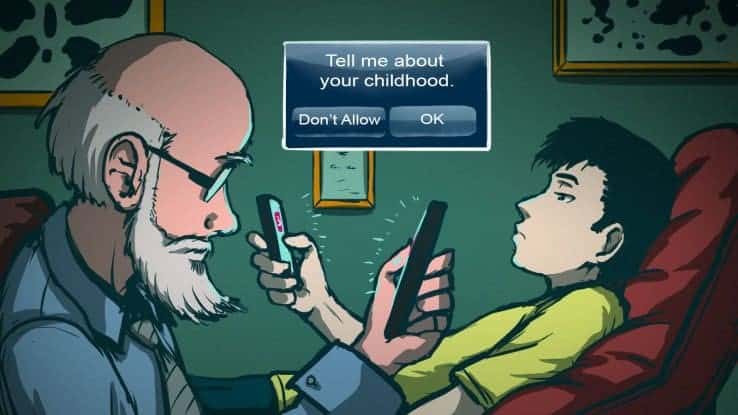What makes push notifications so powerful? They are immediate, personal, and right at your palm. Hence, it is an ideal choice for increasing patient engagement in healthcare mobile apps.
According to data, the average click-through rate (CTR) of the health and fitness industry is 1.61 percent and only 5.01 percent of the users in the healthcare and wellness industry utilize push notification technology. The use of push notifications can increase once there’s enough awareness about its benefits in the healthcare sector.
Push messaging should be like that polite tap on your shoulder from a friend you haven’t seen in a while – immediate, personal, and re-engaging not intrusive or irrelevant. Get your healthcare software development company to get working on integrating push notifications sooner rather than later.
The best healthcare mobile apps know how to use push notifications to their advantage. If you’re new to building an app, though, do check out our detailed guide to evergreen app ideas.
Importance of Push Notification in Healthcare Mobile Apps
- Patient Retention: Push notifications compel the patients to start using their healthcare apps, activate them, and get back to it if not already.
- Traffic Booster: Push notifications are a real gem for in-app actions and mobile app traffic, if configured and complied properly.
- Taking Action on Every Notification: For patients who forget to take medicines, this is a great way to stay on par with medication intake. Notifications also tell the patients about prescription refills, appointment reminders, sleep schedule, vitals, fitness, and more, and compel them to take action on it.
- Constant Update and News: Patients and providers receive timely notification is any new medical resource is available on app, or any new technology is incorporated by healthcare facility. It also notifies about new discounts and offers launched by a practitioner or hospital.
- Constant Monitoring: Push notifications allows providers to monitor patients’ health conditions and notify of any sudden adverse situations.
Ways to Implement Push Notifications in Healthcare Mobile Apps
- Medicine Reminders: Patients struggle to remember their dosages due to busy routine, so send out push notifications to remind patients of their daily medicines.
- Medicine Refills and Availability: E-prescription software can use use push notifications to inform patients about the availability of a medicine, so they can buy them on time. This is necessary for those who cannot afford to miss a single dosage.
- Appointment Reminder: Patients may forget appointments which leads to no-shows and a huge loss for the clinics. So, push notifications can remind patients of their appointments a day or 5 hours prior.
- Regular Check-up and Vaccine Reminders: Regular check-ups and vaccines help in prevention and early diagnosis of diseases. Reminders are a great way to stay on par with routine check-ups and vaccination schedules.
- Health Alert: Smart wearables are connected with healthcare mobile apps and they send regular notifications about sleep cycles, vitals, exercise, water intake, and more. Thus, keeping health in check.
- Symptom Tracker: Providers require data to track patients’ health and push notifications can remind patients to fill up their data on-time, so there’s no time lapse.
- Diet Recommendations: Healthcare apps can use push notifications to send diet tips, especially for diabetic or hypertension patients. Links when attached to push notifications can take users to detailed recipes or diet plans.
Real-World Examples of Push Notifications to Use in Healthcare Apps
#1 Kayak
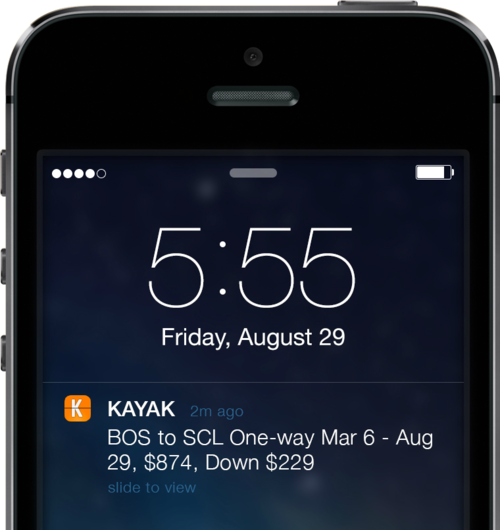
Image source: Localytics
By allowing users to set up flight price notifications, Kayak can then send notifications the moment the price drops. It’s genius because it’s essentially a flash sale disguised as breaking news. They understand the value users find in getting the best deals on flights as soon as possible. That’s why they can get away with sending it at 5:55 am.
#2 Netflix
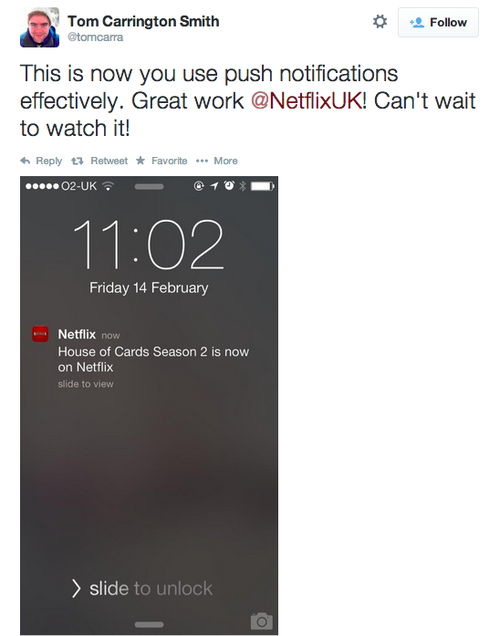
Image source: Quibb
Netflix does a great job of personalizing their notifications to the individual receiving them. Every user receives a unique message about the specific show they have been watching. Rather than sending every user a notification every time a new episode of any show is released, consider one perfectly personalized notification.
This limits and prioritizes the number of pushes each user is eligible to receive.
#3 PLNDR
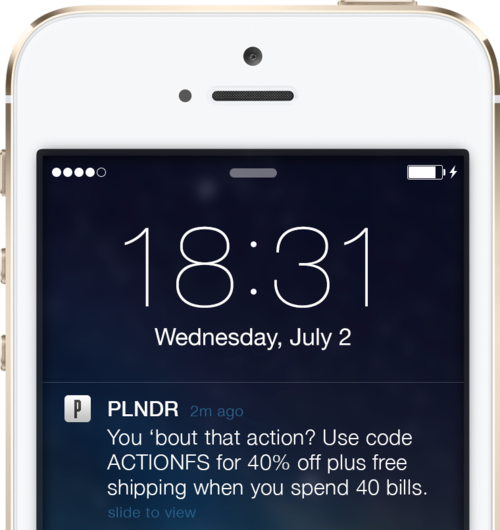
Image source: Localytics
They notify a user if they have added an item to their cart but not completed the purchase yet. By doing this, they are able to drive traffic back to their mobile app in unprecedented ways. These notifications have resulted in an 18% uplift in mobile purchases, as every user receives a personalized message about the specific item waiting for them in their digital shopping cart.
See More: Complete Guide To Building HIPAA Compliant Health Apps
#4 Wanelo

Image source: Jwegan
Social shopping network Wanelo made use of emojis to spice up the text in their push notifications.
Any form of picture works wonder. The app includes emoji characters in the message to try and make the message stand out and grab the user’s attention.
They also started sending push notifications to users who have saved certain items to let them know that those items have gone on sale.
#5 The Bump
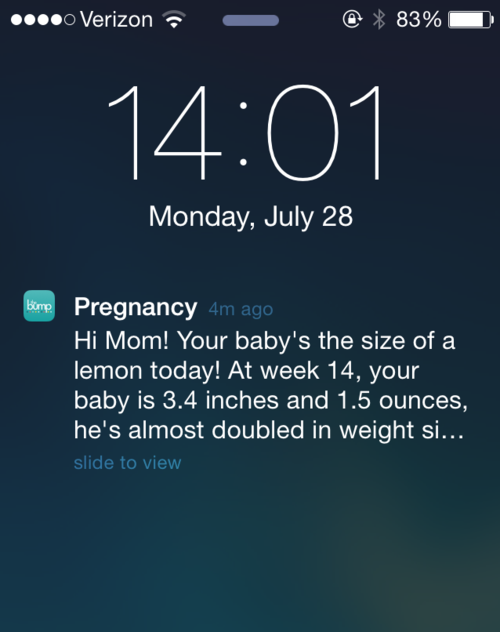
Image source: Localytics
The Bump app use resources and tools to monitor the pregnancy week by week. Any information like this can get really heavy on facts and numbers. But with their unique writing style, the app made users fall in love with their content.
Over the course of the pregnancy, The Bump sends weekly notification updates about the size of the baby (typically in fruit terms) and any other relevant information about what to expect in the upcoming weeks as it tracks the progress of the pregnancy term.
#6 Waze
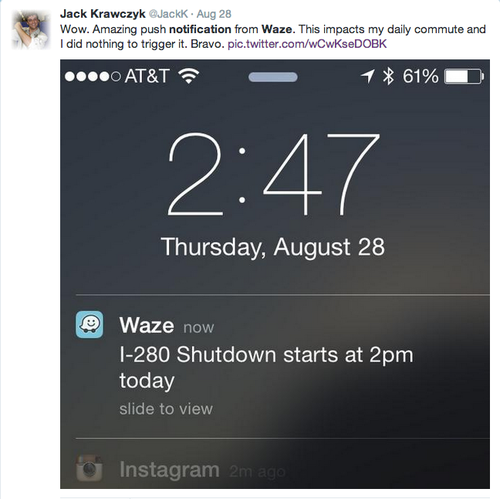
Image source: Quibb
Utility apps have an obvious job to do – know your users daily routines and help them out when they appear to be getting into trouble. That’s what push notification from Waze did!
A notification was sent to Waze users who regularly take the 280 freeway from San Francisco to anywhere in the Silicon Valley. One such notification was about the Subway being shut at certain time. Waze users appreciated the heads up.
#7 Craftsy
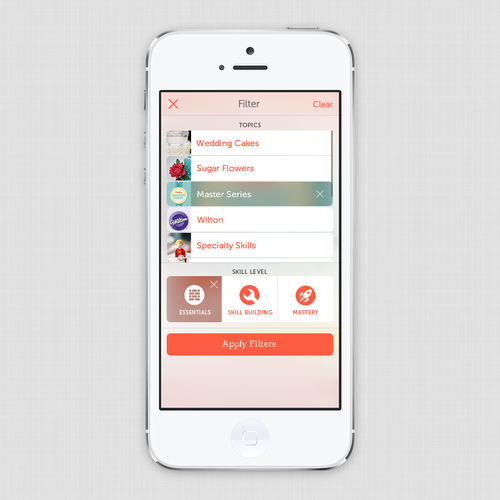
Image source: Dribbble
Craftsy, an app that offers culinary, creative and crafting online classes, uses push notifications to reach its app users, and convert those users into paying customers.
Craftsy also uses purchase history to segment its users. A customer who has signed up for knitting classes would not receive the same notification as a customer who has only signed up for photography classes. The Craftsy app also includes a message center where notifications are stored in an inbox for consumers to read when it’s convenient to them.
See More:
- Complete Guide To Software as a Medical Device
- How to start a telehealth practice
- How To Make An App HIPAA Compliant
- How to start a telemedicine practice as a nurse practitioner
#8 Cluster
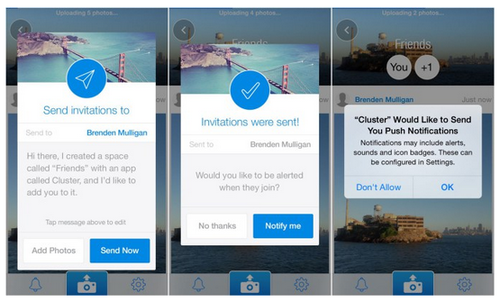
Image source: TechCrunch
You have one shot to ask for push permissions; ensure it isn’t wasted. The app hit the right nerve by diverting the initial question and gauging the user’s interest.
Cluster utilizes this tactic to achieve a 60% push enablement rate in the social category, with 100% of users opting into push after tapping “Notify Me” in their pre-ask page.
If the user clicks “YES” in the pre-ask page, it prompts them to the official permission page; if the user clicks “NO,” it waits until they are more familiar with the app and ask them again later.
#9 Google Now
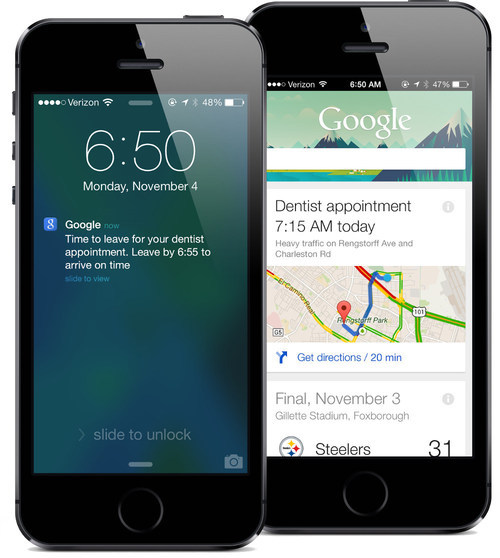
Image source: Engadget
Since Google gets all your information through various sources it sends you notifications after filtering this information.
For example: If you bought a plane ticket and had the confirmation email sent to your Gmail account, then Google Now will send you a notification, as well as display a trip itinerary card in your feed a day or two before your flight.
If you opt for the reminders option in Google Now, it will tell you when to leave for an appointment based on what it knows about their location, traffic conditions and mode of transport. Like, “Leave by 11:25 am to arrive on time.”
Use the above best practices to craft a great push messaging campaign that’s promising not “pushy.” If you haven’t made push a part of your mobile strategy, it’s time you do now!
Header image source: Mappmedia
Wrapping Up
In conclusion, healthcare mobile app’s push notifications serve as a vital bridge between users and their well-being. With real-time updates, personalized health insights, and timely reminders, push notifications are committed to empowering individuals on their wellness journey. By leveraging the power of technology to deliver pertinent information directly to users’ fingertips, push notifications aim to foster a proactive approach to health management.
Embrace the future of personalized healthcare with healthcare mobile apps that are developed to serve your purpose and needs. We at Arkenea aim to deliver world-class healthtech products that meet yours and industry standards. Connect with us for a quote.
